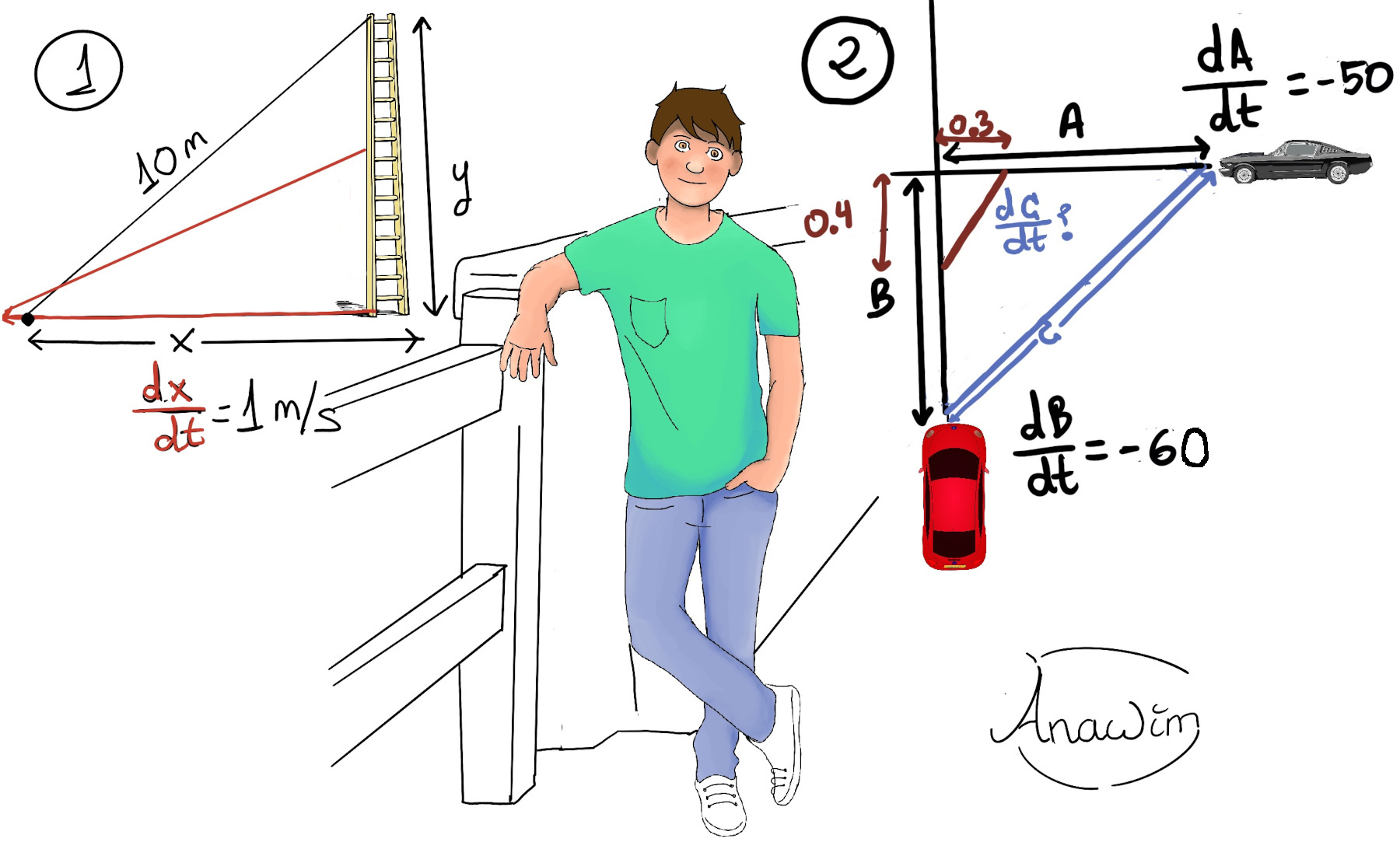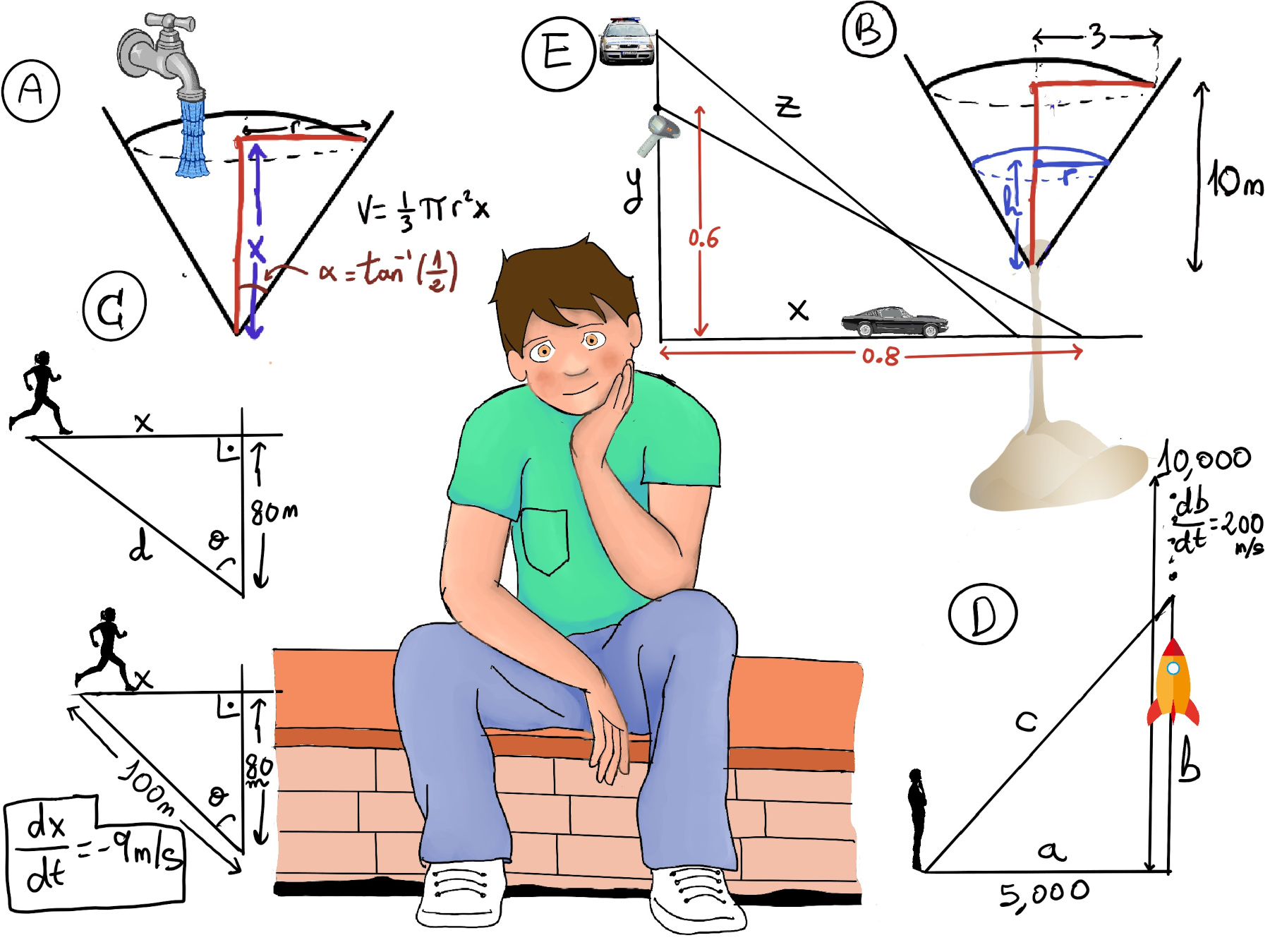
|
 |
 |

|
 |
 |
Thinking, wishing, or wanting something does not make it real. Dreams are only dreams and nothing more. Life is not fair nor easy. A lie repeated a thousands times is still a lie. Propaganda and narratives cannot change the facts. Either you deal with what reality is, whether you like it or not, or you can be sure that reality is going to deal with you and chances are that it won’t be nice, JustToThePoint, Anawim, #justtothepoint.
The derivative of a function at a chosen input value, when it exists, is the slope of the tangent line to the graph of the function at that point. It is the instantaneous rate of change, the ratio of the instantaneous change in the dependent variable to that of the independent variable.
Definition. A function f(x) is differentiable at a point “a” of its domain, if its domain contains an open interval containing “a”, and the limit $\lim _{h \to 0}{\frac {f(a+h)-f(a)}{h}}$ exists, f’(a) = L = $\lim _{h \to 0}{\frac {f(a+h)-f(a)}{h}}$. More formally, for every positive real number ε, there exists a positive real number δ, such that for every h satisfying 0 < |h| < δ, then |L-$\frac {f(a+h)-f(a)}{h}$|< ε.

The critical points of a function f are the x-values, within the domain (D) of f for which f’(x) = 0 or where f’ is undefined. Notice that the sign of f’ must stay constant between two consecutive critical points. If the derivative of a function changes sign around a critical point, the function is said to have a local or relative extremum (maximum or minimum) at that point. If f’ changes sign from positive (increasing function) to negative (decreasing function), the function has a local or relative maximum at that critical point. Similarly, if f’ changes sign from negative to positive, the function has a local or relative minimum.
f’(x) is the slope of the line tangent to the graph of f at that particular point (x, f(x)). f’(x) is also the rate of change of the function at x. The average rate of change is the process of calculating the rate at which the output (y-values) changes compared to its input (x-values). This can be visualized as the slope of a secant line passing between two points on a function. In differential calculus, the focus shifts to the instantaneous rate of change, which is found using the derivative of a function.
For example, Growth Rate = $\frac{Births-Deaths}{years}$. The rate of change in population is the derivative of the population function with respect to time, $\frac{dP}{dt}$.
You should follow these general steps:

The diagram is shown in Figure 1. By the Pythagorean theorem, x2 + y2 = 102.
Let’s differentiate by t the previous formula, $2x·\frac{dx}{dt}+2y·\frac{dy}{dt} = 0$ (🚀). Our goal is to calculate $\frac{dy}{dt}$ when x = 6 (⇒ y = $\sqrt{10^2-6^2} = \sqrt{100-36} = \sqrt{64} = 8$), and we also know that $\frac{dx}{dt}=1$, so let’s plug in all of these values in (🚀) $2x·\frac{dx}{dt}+2y·\frac{dy}{dt} = 0 ↭ 2·6·1 + 2·8·\frac{dy}{dt} = 0 ⇒ \frac{dy}{dt} = \frac{-12}{16} = \frac{-3}{4}.$ The top of the ladder is sliding down at a rate of -0.75m/s.

The diagram is shown in Figure 2. By the Pythagorean theorem, A2 +B2 = C2. We differentiate by t, $2·A·\frac{dA}{dt}+2·B·\frac{dB}{dt} = 2·C·\frac{dC}{dt}$ [🚀]
We are asked $\frac{dC}{dt}$ when car A is 0.3 meters and car B is 0.4 from the intersection. A = 0.3, B = 0.4 ⇒ $0.3^2+0.4^2 = C^2 ⇒ C = \sqrt{0.25} = 0.5$. We are also told that $\frac{dA}{dt} = -50, \frac{dB}{dt} = -60.$
Let’s plug in all these values in [🚀] ⇒ $2·A·\frac{dA}{dt}+2·B·\frac{dB}{dt} = 2·C·\frac{dC}{dt} ⇒ 2·0.3·(-50) + 2·0.4·(-60) = 2·0.5\frac{dC}{dt} ⇒ \frac{dC}{dt} = -78m/h$, that is, the cars are approaching each other at a rate of 78m/h.
$\frac{dV}{dt}=12.8·π$. Goal: r when $\frac{dr}{dt} = 0.2$?
Recall that the volume of a sphere is V = $\frac{4}{3}πr^3 ⇒ \frac{dV}{dr} = 4·π·r^2 ⇒ \frac{dr}{dV} = \frac{1}{4·π·r^2}.$
$\frac{dr}{dt} = \frac{dr}{dV}·\frac{dV}{dt} ⇒ 0.2 = \frac{dr}{dV}·\frac{dV}{dt} = \frac{1}{4·π·r^2}·12.8 ⇒ r^2 = \frac{12.8·π}{0.2·4·π} = \frac{12.8}{0.8} = 16 ⇒ r = ±4$ ⇒[A radius is obviously positive] r = 4m.
The diagram is shown in Figure E. By the Pythagorean theorem, x2 + y2 = z2 ⇒[We differentiate by t] $2x\frac{dx}{dt} +2y\frac{dy}{dt}= 2z\frac{dz}{dt}$
Our goal is $\frac{dx}{dt}$ when y = 0.6, x = 0.8 (x2 + y2 = z2 ↭ $z = \sqrt{0.6^2+0.8^2}$ = 1), $\frac{dz}{dt} = 20, \frac{dy}{dt} = -60$.
Let’s plug in these values into the previous formula, $2x\frac{dx}{dt} +2y\frac{dy}{dt}= 2z\frac{dz}{dt} ⇒ 2·0.8·\frac{dx}{dt} +2·0.6·(-60) = 2·1·20 ⇒ 1.6·\frac{dx}{dt} = 40+72 ⇒ \frac{dx}{dt} = \frac{40+72}{1.6} = 70mph.$


a = 5,000 meters. $\frac{db}{dt}\bigg|_{10,000} = 200m/s$
a2 + b2 = c2. In that particular moment, $5,000^2+10,000^2 = c^2⇒ c = \sqrt{5,000^2+10,000^2} = \sqrt{5,000^2+5,000^2·2^2} = 5,000\sqrt{1+2^2} = 5,000·\sqrt{5}$
a2 + b2 = c2 ⇒ $\frac{d(a^2+b^2)}{dt} = \frac{dc^2}{dt} ⇒ 2a·\frac{da}{dt}+2b·\frac{db}{dt} = 2c\frac{dc}{dt} ⇒ 2·5,000·0+2·10,000·200 = 2·5,000·\sqrt{5}·\frac{dc}{dt} ⇒ 4,000,000 = 10,000\sqrt{5}·\frac{dc}{dt} ⇒ \frac{dc}{dt}=\frac{4,000,000}{10,000·\sqrt{5}} = \frac{400}{\sqrt{5}}=\frac{400·\sqrt{5}}{\sqrt{5}·\sqrt{5}} = \frac{400·\sqrt{5}}{5} = 80·\sqrt{5}m/s.$
$\frac{dV}{dt}=150, \frac{dh}{dt}\bigg|_{h=1.4}?$
V = $3·(2 + \sqrt{h})^6-192 ⇒ \frac{dV}{dt} = 150 = 3·6·(2 + \sqrt{h})^5\frac{1}{2\sqrt{h}}\frac{dh}{dt}⇒\frac{dh}{dt} = \frac{150·\sqrt{h}}{9·(2 + \sqrt{h})^5}$
$\frac{dh}{dt}\bigg|_{h=1.4} = \frac{150·\sqrt{1.4}}{9·(2 + \sqrt{1.4})^5}$ ≈ 0.06 m/s.
We know that 32 + b2 = c2, $\frac{db}{dt}=480$
480 miles ———- 1h = 60*60 seconds
b miles ———— 30 seconds
b = $\frac{480·30}{60·60} = 4 miles$ ⇒[32 + b2 = c2] c = 5.
The diagram is shown in Figure 2.b.

32 + b2 = c2 ⇒ 2b$\frac{db}{dt} = 2c\frac{dc}{dt}$. Now, we can insert the values in this equation, $2·4·480 = 2·5·\frac{dc}{dt}⇒~ \frac{dc}{dt}=384mph$∎